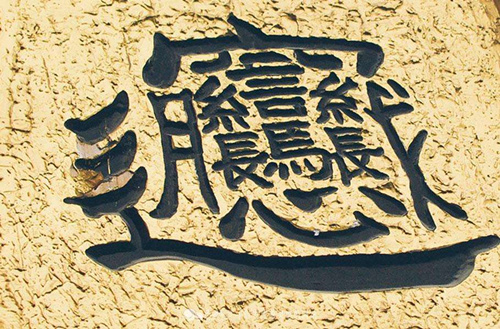
. > WHAT'S NEW > RESEARCH
Review of writing system aims to tackle ‘character amnesia’
Author : XIAO HAOCHEN Source : Chinese Social Sciences Today 2017-09-12

One of the most complicated Chinese characters, biang, has 9 radicals and 57 strokes.
In the internet age, Chinese characters are facing a new challenge: an increasing number of people have contracted “character amnesia.”
Constantly emerging modern technologies and smart devices have led to a decrease in handwriting. Recently, Dazhong Daily surveyed 500 university students in Wuhan, Hubei Province, on their writing habits. The survey showed that 52 percent of them are using handwriting less often and 27 percent said they had trouble remembering how to write characters. Around 83 percent said the reason for this was the popularization of PCs, smartphones and new media.
Living fossil
Characters are a form of intangible heritage that preserve and develop Chinese history and culture. Quan Gen, a research fellow from the National Library of China, said Chinese characters have overcome the spatial and temporal limitations of language transmitted by sound, which rendered them a powerful carrier for the continuation of Chinese civilization. In history, though characters had various forms, such as the inscriptions on bones or tortoise shells of the Shang Dynasty, the seal characters in the Qin Dynasty, the original complex form of a simplified Chinese character, and the simplified Chinese used today, they share the same root. Embodying the lifestyles and ways of thinking of the Chinese nation, characters are a living fossil of Chinese civilization.
Wang Yongmin, a committee member of the China Association for Science and Technology and the father of the “five-stroke” input method, said characters are one cornerstone of national unification. The first Emperor of Qin united the forms of writing at that time and thus consolidated the unification of the ancient empire. In addition, the biggest advantage of Chinese characters is that they do not differ among various dialects. There are hundreds of dialects in China but only one writing system. The consistency in writing models helped the cultural unity of the Chinese nation, Wang added.
Meaning revealed in shape
Quan said that as ideographs, Chinese characters are shaped in a way that gives clues to the meaning of the characters. For example, the character lao 牢, basically meaning “prison” consists of two parts: the upper part mian宀 (house, covering) and the lower part niu 牛 (cow). Together, the character “prison” represents “a cow trapped in a house.”
In terms of the structure of characters, radicals are the smallest parts comprising a character. For example, the character miao苗(seeding) consists of two radicals cao艹(grass) and tian田(field). The cao part suggests that miao is basically a king of plants, and the tian part indicates that miao is related to soil. In addition, some characters have only one radical while others have many radicals. For example, the simple yi一, (one) has only one radical and one of the most complicated characters biang has 9 radicals 57 strokes. However complicated, Chinese characters are square characters. The unique pattern enables characters to embody rich cultural connotations and the capacity to develop the art of calligraphy.
The structural characteristics of Chinese characters are not only revealed in the recognition and understanding of a single character, but also presented in the whole writing system. Quan said in Paraphrasing Texts and Words, the first Chinese dictionary written by Xu Shen in the Han Dynasty, that the radicals, shape of the character, meaning, pronunciation and the relationship between these elements are all systematic. In general, all characters compose a big system, in which every radical has a subsystem. These subsystems are like a big network in which every character has a specific position. For Chinese learners, a mastery of the shaping rules of characters will yield twice the result with half the effort.
In addition to the instrumental nature of language, characters have unique aesthetic value. Chang Yaohua, a professor from the Beijing International Studies University, said that Chinese characters have had various forms from the ancient time to the present, many of which are useful resources for artistic use.
In order to avoid the increasingly prevalent “character amnesia,” media participation is also important for promoting public awareness of the cultural significance embedded in Chinese characters. The TV show Dictation Assembly of Chinese Characters, which has played for three seasons, is a good example of a way to remind people of the value of characters.
Ye Shengtao made Chinese fairy tales from a wilderness
Ye Shengtao (1894–1988) created the first collection of fairy tales in the history of Chinese children’s literature...
-
How northern ethnicities integrated into Chinese nation
2023-09-18
-
Mogao caves
2023-09-12
-
Mogao Grottoes as ‘a place of pilgrimage’
2023-09-12
-
Time-honored architectural traditions in China
2023-08-29
-
Disentangling the civilizational evolution of China
2023-08-28
-
AI ethics in science fiction
2023-08-23













 2011-2013 by www.cssn.cn. All Rights Reserved
2011-2013 by www.cssn.cn. All Rights Reserved